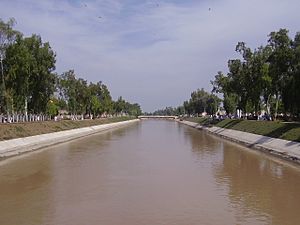Bhakkar facts for kids
Quick facts for kids
Bhakkar
بھكّر
|
|
|---|---|
|
Location in Punjab, Pakistan
|
|
| Country | |
| Province | |
| Division | Mianwali |
| District | Bhakkar |
| Elevation | 159 m (522 ft) |
| Population
(2023 census)
|
|
| • City | 131,658 |
| • Rank | 86th, Pakistan |
| Time zone | UTC+5 (PKT) |
| Calling code | 0453 |
| Union councils | 26 |
Bhakkar (Urdu: بھكّر) is an important city in Punjab, Pakistan. It sits on the left side of the Indus River. It is the main city of Bhakkar District. Bhakkar is also one of the largest cities in Pakistan.
Contents
How Bhakkar is Managed
Bhakkar city is the main office for Bhakkar Tehsil. A tehsil is like a smaller administrative area. Bhakkar Tehsil is one of four such areas in the district. It is divided into 17 smaller parts called union councils. Three of these union councils make up the city of Bhakkar itself.
Bhakkar's History
Bhakkar was likely started in the late 1400s. A group of people from Dera Ismail Khan settled there. The city is named after a person called Bakhar Khan.
Mughal Rule in Bhakkar
In 1555, the city came under the rule of Humayun. He was a powerful emperor who brought back the Mughal Empire. Humayun chose Khan Khanan to be the governor of Bhakkar. Bhakkar was part of the larger Multan province of the Mughal Empire.
A Traveler's Visit
In 1641, a Portuguese traveler named Fray Sebastian Manrique visited Bhakkar. He wrote that Bhakkar was the capital of a kingdom at that time.
British Rule in Bhakkar
Later, during the time of British rule, Bhakkar Town was part of Mianwali District. It was still located on the left bank of the Indus River. A railway line, called the North-Western Railway, also went through the town.
The Imperial Gazetteer of India, a book from that time, described Bhakkar. It said the town was on the edge of a sandy plain. This plain looked over the lower lands near the river. A part of the river could be used by boats during floods.
To the west of Bhakkar, the land was low and good for farming. It would sometimes get flooded. To the east, the land was high, dry, and sandy, with no trees. Below the town, there was rich land that was watered by wells. This land was protected from river floods by special walls. It could grow two or three crops each year.
Near the river, there were many date palm groves and fruit gardens. There was even a famous mango tree. Its fruit was sent all the way to Kabul when the Afghans ruled the area. Bhakkar became a municipality, or a self-governing town, in 1874. In 1901, about 5,312 people lived there. The town had a small clinic and a school.
Interesting Places and Products
Dilkusha Bagh
Dilkusha Bagh is a very old date orchard in Bhakkar. People believe it was a Mughal garden. It might have been built by Emperor Humayun or Akbar. This garden has hundreds of different kinds of rare date palms. It also has common dates like the Basra dates.
Karna Oil
Bhakkar is also known for making Karna oil. This special oil comes from Karna flowers. The flowers are used in many ways. But the most common way is to make oil from them. The sweet smell of the flowers is taken out. Then it is added to mustard oil. Other spices like cloves, cardamom, and jasmine are also mixed in.
The final product is called ‘karna oil’. People believe this oil is very good for hair problems. It is thought to help with things like dandruff and hair loss.
See also
 In Spanish: Bhakkar para niños
In Spanish: Bhakkar para niños




